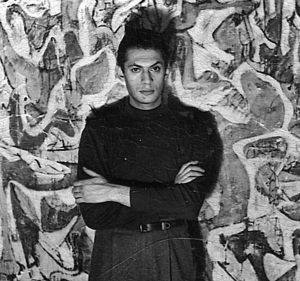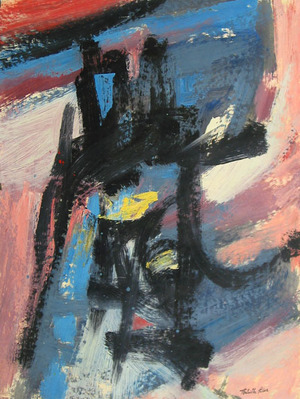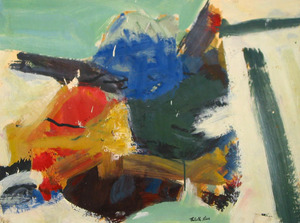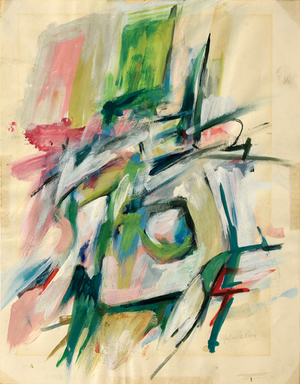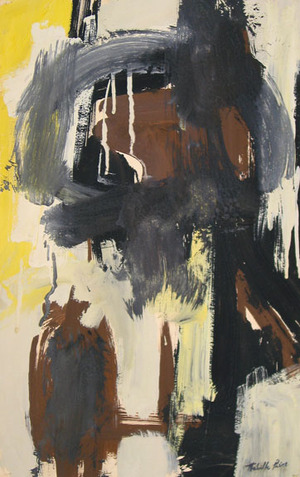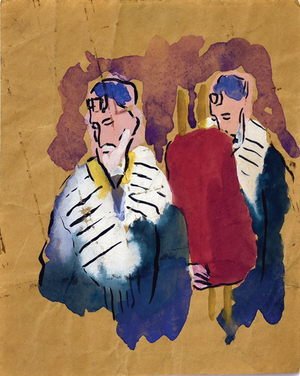Melville Price
Melville Price was one of the youngest of the first generation Abstract Expressionist circle of painters working in New York after WWII. Though only in his late twenties he began exhibiting in 1948 in New York at Hugo, Bodely, Iolas and Egan galleries. In a 1949 showing at Peridot galleries Price was hailed for his breakthrough work titled the "Maze Series." A complex interweaving of organic shapes, automatic in nature and sometimes resembling bones or body parts, the "Maze" paintings exuded a pulsating energy that brought him critical acclaim. He received rave reviews in Art Digest, New York Times and New York Tribune. Melville Price was on his way. Melville Price grew up in a prosperous family in Kingston, New York where he had a studio in the family home from an early age. The Depression began to take a toll on the family business and the untimely death of his father in 1939 was a devastating blow from which Price never fully recovered. Unable to afford formal schooling, Price began studying informally at the Art Students League, the New School for Social Research and the National Academy of Design. Prior to his father's death Mel befriended the painter Joseph Stella who became his artistic guide and mentor, introducing him to the avant-garde styles of cubism and surrealism and encouraging the younger painter to experiment. Price also got a job with the WPA where he met the older generation of modern painters including Gorky, de Kooning, Pollock and Kline. Franz Kline, in particular, became a life-long friend and soul mate. Between 1946 and 48 his style moved away from a surrealist based work to a decentralized, all-over manner of painting which eventually became the "Maze" works. When the "Club" was started Price was invited to join and forged close relationships with other members of the New York School including Fritz Bultman, Giorgio Cavallon, Weldon Kees, Bradley Walker Tomlin, Robert Motherwell, Milton Resnick and Conrad Marca-Relli. In 1951 he was honored to be included in the 9th St. Show, the premier event of the Abstract Expressionist movement. In spite of this success, as with most of his colleagues, money was scarce and Price supplemented his income working for the framemakers Benevi & Feist and the House of Heydenryck. Still, times were tough and in 1951 he and Kline accepted part-time jobs teaching in Philadelphia at the Museum School, commuting together a couple of days each week between the two cities. Price found that he liked teaching, enjoyed the paycheck and there was a thriving abstract art scene there that somewhat paralleled what was happening in New York. After the first year Kline gave up the job and Price moved full time to Philadelphia where he began exhibiting with Dubin and Hendler galleries. In 1955 he married one of his students, Barbara Gillette and the couple moved soon to the picturesque town of New Hope on the Delaware River. There Price began his next major cycle of paintings titled the "New Hope Series." Though different in composition, these vibrant, muscular works were a logical extension of the successful "Maze" paintings and brought Price positive attention. In 1958 he accepted a visiting teaching position (which would become a full time appointment) at the University of Alabama. Mel and Barbara spent twelve happy years in Tuscaloosa — known as the "Yale of the South," it was an energetic, liberal bastion of creativity with a fabulous faculty and student body. In 1962, with a sabbatical from the University, Price began work on an ambitious project called the "Black Warrior," a 9 x 16 foot canvas on which he completed in 1963. He followed the success of "Black Warrior" with a new series of large, mixed media assemblage canvases incorporating new elements of oil and collage with references to POP, Rauschenberg and Johns. These works, in turn, were pointing the painter in yet another exciting direction when he suddenly died of a massive heart attack in 1970. After his death Price was honored with retrospective exhibitions at the University of Alabama, the Speed Museum and the Corcoran Gallery. He is represented in numerous private and public collections including the Art Institute of Chicago, the Corcoran Museum of Art, the Los Angeles Museum County Museum of Art and the Milwaukee Art Museum. We have represented his estate for eighteen years.





























